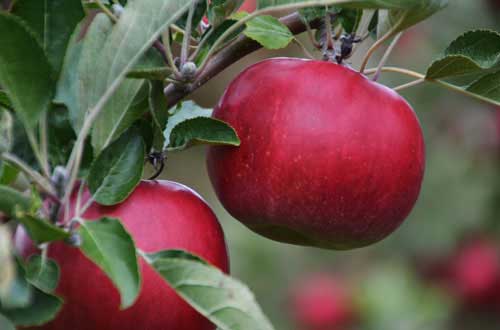Fed disaster declaration approved for Orleans, most upstate counties from May freeze
Press Release, U.S. Senate Majority Leader Charles Schumer’s Office

Photo by Tom Rivers – This photo from October 2015 shows apples at an Albion orchard. Orleans County is one of the leading apple-growing counties in the state, behind only Wayne and Ulster counties.
Following their repeated calls earlier this year, U.S. Senate Majority Leader Charles E. Schumer and U.S. Senator Kirsten Gillibrand today announced the U.S. Department of Agriculture has approved the New York State Farm Service Agency’s request for a federal Agricultural Disaster Designation following this past May’s deep freeze that destroyed thousands of acres of crops for 31 counties across Upstate New York.
Schumer personally called USDA Secretary Vilsack to advocate on New York’s behalf, and working with Senator Gillibrand fought to deliver the disaster designation for NY. The senators said Upstate NY suffered major crop damage from the extreme cold weather this past May, destroying grapes, apples, strawberries, blueberries, and other crops vital to the Upstate NY economy, and that with harvest season just beginning, this relief will be critical to supporting impacted farmers on the long road to recovery.
The Secretarial disaster designation has officially been approved for 31 counties including Albany, Broome, Cattaraugus, Cayuga, Chautauqua, Chemung, Columbia, Cortland, Dutchess, Greene, Jefferson, Onondaga, Ontario, Orleans, Oswego, Otsego, Putnam, Rensselaer, Saratoga, Schenectady, Schoharie, Schuyler, Seneca, Steuben, Tioga, Tompkins, Ulster, Washington, Wayne and Westchester and Yates.
The senators also said that an additional 24 counties across Upstate NY have been designated by the USDA as contiguous disaster counties including: Allegany, Fulton, Madison, Orange, Bronx, Genesee, Monroe, Rockland, Chenango, Hamilton, Montgomery, St. Lawrence, Delaware, Herkimer, Nassau, Sullivan, Erie, Lewis, Niagara, Warren, Essex, Livingston, Oneida, and Wyoming.
“From the vineyards of the Finger Lakes to the orchards of the Capital Region, family-owned farms are the backbone of Upstate New York’s agriculture economy,” Schumer said. “But this past May they suffered from one of the most devastating deep freezes in recent memory, destroying thousands of acres of crops.”
A Secretarial disaster designation makes farm operators in primary counties and counties contiguous eligible to be considered for critical low-interest FSA Emergency Loans. Impacted NY producers will be able to borrow up to 100 percent of the actual amount of production or physical losses to a maximum amount of $500,000.
According to the USDA, emergency loan funds may be used to: restore or replace essential property, pay all or part of production costs associated with the disaster year, pay essential family living expenses, or reorganize the farming. Farmers in eligible counties have 8 months from the date of a Secretarial disaster declaration to apply for emergency loans. Local FSA offices can provide affected farmers with further information.
“This past May’s deep freeze destroyed thousands upon thousands of acres of crops, threatening the livelihoods of farmers and their communities,” said Senator Gillibrand. “This designation unlocks emergency relief funds for farm operators in eligible counties and my message to farmers is this: apply for this relief quickly and my office is here to support you.”
The severe cold temperature and frost in May resulted in significant crop losses for several types of fruit, including grapes, apples, strawberries, peaches, pears, plums, blueberries, apricots, cherries, and caneberries across the state and flower and hay damage in certain areas. According to the National Weather Service, New York had multiple dates where the temperature dropped below freezing between May 14 and May 25, but the time period that caused the most widespread damage happened overnight from May 17 to May 18.
These freezing temperatures caused severe frost damage to multiple crops across the majority of the state. However, Schumer said that grapes and apples were hit especially hard, with vineyards across New York reporting losses ranging from 5 to 100 percent.
According to Empire State Development, New York State is the third-largest producer of grapes, grape juice and wine in the United States. In addition, the state is the second-largest producer of apples in the country. These crops make a significant contribution to the state’s agricultural economy and support many local businesses and jobs, employing close to 100,000 New Yorkers and producing $11.5 billion worth of economic impact annually.










































































